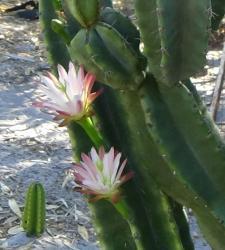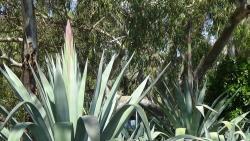

skopjecollection said:You live in australia , right? Do you have any of the invasive harrisa?
skopjecollection said:....it seems you have no idea what im talking about, and arent well versed in nomenclature...
>>The plant" Cereus NOID x Echinopsis hybrid" doesn't exist. The plant you're referring to is trichocereus(which has been split from regular cereus ) and is now under echinopsis.....
>>Its basically just an echinopsis hybrid...nothing intergenic....
---You're right it is grafted. The parent Echinopsis hybrid, see https://garden.org/pics/2018-1..., flowered last night.
---Cereus NOID, this is the other parent, a Cereus of unknown parentage. It has a flower such as you mention as being for a true Cereus, and no, it is not the rootstock.
>>The difference would be that true cereus(like your first plant) have long tubular flowers which are hairless and spineless...
Trichocereus, and it shares this trait with echinopsis , has long tubular hairy flowers........often covered with scales...
>>From what it looks like, the echinopsis may be grafted instead.....
skopjecollection said:Nope. Cereus and echinopsis dont interbreed....
Look it up.
Echinopsis is in the trichocereae tribe, cereus is in the cereae tribe. No hybrids exist..
Grafting does not make hybrids...
Echinopsis does a lot of hybrids with relatives(or plants that are now under echinopsis), among the lines of echinopsis x trichocereus, x lobivia, x cleistocactus, x matucana, x oreocereus etc...
skopjecollection said:None. Hylocereniae (disocactus(former aporocactus), epiphyllum, hylocereus, selenicereus,weberocereus and psedorhipsalis )dont form hybids with other plants..
Epiphyllum and disocactus can mix, and a lot, and they are popular...
Ive heard of hybrids between those 2 and selenicereus, or selenicereus and hylocereus, but could be mix ups at best...
mcvansoest said:So, at risk of getting involved in this, I have to ask for a clarification.
Like Stefan says it looks like you grafted an echinopsis (or Trichocereus) cutting to a Cereus - your C. noid. The Echinopsis flowered and set fruit and you think that fruit contains seed that is of hybrid origin between the Cereus and the Echinopsis grafted onto it?
Is my understanding correct?
- No, the echinopsis is grafted to one of my seedlings
If so, my question is - how do you know that the Echinopsis flower was fertilized with pollen form the Cereus flower?
Did you do it yourself?
- Yes
If not how can you be certain that a sneaky bee, or other insect, or any kind of local interested pollinator, did not pollinate the plant with pollen from another plant in flower at the same time that was potentially more compatible or if it may have self pollinated, which is not completely unknown among some Echinopsis species.
- Flowers are restrained from opening with rubber bands which are re-applied following the pollination.
I do not know if Cereus x Echinopsis hybrids are possible. I am inclined to think no, because I would have expected there to be oodles out there to try and make Cereus sized plants with brightly colored flowers. The whole reason people started hybridizing Echinopsis/Trichocereus/Lobivia/etc in the first place, was to create larger plants readily flowering plants with brightly colored large flowers, Cereus would have been the obvious target as a hybridizing partner in terms of overall plant size and flower size, if they were compatible.
If not, I do not understand how you can think you have acquired something that is a hybrid between Cereus NOID and the grafted on Echinopsis?
- Sowed seed after collecting it from the dried fruit.
If the Echinopsis produced an offset on its own stem, then that is just another Echinopsis hybrid of the same kind genetically identical to the plant that produced it. If you graft a plant on another plant the plant it is grafted on takes care of the scions needs as in water and nutrients, but their genetics do not automatically mix unless you successfully produce viable seed from cross pollinating between the flowers of the different species, but unless you did that in a controlled environment you have no way of knowing if those two plants actually were crossed with each other.
Sorry if this is all really basic to you, but the discussion here got really confusing to me.
- In summary I follow normal breeding protocols.
